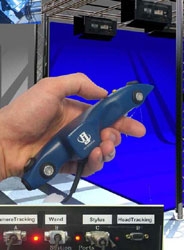 |
Abstract: Vibrotactile Pitfalls: Arm Guidance for Moderators in Virtual TV Studios
Monika Klapdohr, Björn Wöldecke, Dionysios Marinos, Jens Herder, Christian Geiger, and Wolfgang Vonolfen. Vibrotactile Pitfalls: Arm Guidance for Moderators in Virtual TV Studios, 13th International Conference on Human and Computer, Hamamatsu/Aizu-Wakamatsu/Duesseldorf, December, 2010.
For this study, an experimental vibrotactile feedback sys- tem was developed to help actors with the task of moving their arm to a certain place in a virtual tv studio under live conditions. Our intention is to improve interaction with virtual objects in a virtual set, which are usually not directly visible to the actor, but only on distant displays. Vibrotactile feedback might improve the appearance on tv because an actor is able to look in any desired direction (camera or virtual object) or to read text on a teleprompter while interacting with a virtual object. Visual feedback in a virtual studio lacks spatial relation to the actor, which impedes the adjustment of the desired interaction. The five tactors of the implemented system which are mounted on the tracked arm give additional information like collision, navigation and activation. The user study for the developed system shows that the duration for reaching a certain target is much longer in case no visual feedback is given, but the accuracy is similar. In this study, subjects reported that an activation signal indicating the arrival at the target of a drag & drop task was helpful. In this paper, we discuss the problems we encountered while developing such a vibrotactile display. Keeping these pitfalls in mind could lead to better feedback systems for actors in virtual studio environments.
Keywords:
vibrotactile feedback, virtual studio, mixed reality
|
 |
